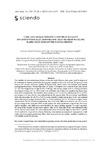Please use this identifier to cite or link to this item:
https://accedacris.ulpgc.es/jspui/handle/10553/70028
| DC Field | Value | Language |
|---|---|---|
| dc.contributor.author | Guzmán, José Luis | - |
| dc.contributor.author | De La Vega, Francisco | - |
| dc.contributor.author | Zarazaga, Luis Ángel | - |
| dc.contributor.author | Argüello Henríquez, Anastasio | - |
| dc.contributor.author | Delgado-Pertíñez, Manuel | - |
| dc.date.accessioned | 2020-02-05T12:51:59Z | - |
| dc.date.available | 2020-02-05T12:51:59Z | - |
| dc.date.issued | 2019 | - |
| dc.identifier.issn | 1642-3402 | - |
| dc.identifier.other | Scopus | - |
| dc.identifier.other | WoS | - |
| dc.identifier.uri | https://accedacris.ulpgc.es/handle/10553/70028 | - |
| dc.description.abstract | The viability of conventional goat farms, such as the native Payoya dairy goat, could be improved by switching to organic production, but product quality needs to be ensured. The present work assesses the carcass and meat quality of Payoya kids raised under conventional and organic grazing-based systems. Twenty-four kids (12 males, 12 females) were selected from each system (n = 48). The slaughter live weight (8.52 vs. 8.28 kg), cold carcass weight (4.44 vs. 4.29 kg) and farm dressing percentage (51.7 vs. 50 %) of the conventionally raised kids were significantly higher than those of the organic kids. The shoulder (first category) (21.7 vs. 22.3 %) and long leg (32 vs. 32.9 %) percentages were lower in the conventional than in the organic kids. The percentage contribution of the intermuscular fat (10.70 vs. 8.11 %) to the shoulder weight was greater in the conventional kids, while the percentage of muscle (59.7 vs. 57.2 %) and bone (24.7 vs. 22.8 %) were higher in the organic kids. For the chemical composition, there were only differences between the two sexes in the percentage of fat (6.64 and 7.99 % on dry matter, for male and female, respectively). For rheological variables, only differences were found in the water holding capacity (% water expelled), the meat of the organic females had a higher value (17 %) than that of the conventional females (14 %). For the meat colour, the conventional male kids returned the highest values for C∗ and H (14.32 and 64.34, respectively). Farms following conventional grazing-based management could easily switch to organic production. Most of the meat and carcass quality variables studied were very similar across the systems. | - |
| dc.language | eng | - |
| dc.relation.ispartof | Annals of Animal Science | - |
| dc.source | Annals Of Animal Science[ISSN 2300-8733],v. 19 (4), p. 1143-1159, (Octubre 2019) | - |
| dc.subject | 3104 Producción Animal | - |
| dc.subject.other | Convencional Farm | - |
| dc.subject.other | Gender | - |
| dc.subject.other | Grazing Systems | - |
| dc.subject.other | Livestock Production System | - |
| dc.subject.other | Organic Farm | - |
| dc.title | Carcass Characteristics And Meat Quality Of Conventionally And Organically Reared Suckling Dairy Goat Kids Of The Payoya Breed | - |
| dc.type | info:eu-repo/semantics/article | - |
| dc.type | Article | - |
| dc.identifier.doi | 10.2478/aoas-2019-0047 | - |
| dc.identifier.scopus | 85072250394 | - |
| dc.identifier.isi | 000493751400019 | - |
| dc.contributor.authorscopusid | 55667552800 | - |
| dc.contributor.authorscopusid | 55843825600 | - |
| dc.contributor.authorscopusid | 6603458050 | - |
| dc.contributor.authorscopusid | 6701710018 | - |
| dc.contributor.authorscopusid | 6507900281 | - |
| dc.description.lastpage | 1159 | - |
| dc.identifier.issue | 4 | - |
| dc.description.firstpage | 1143 | - |
| dc.relation.volume | 19 | - |
| dc.investigacion | Ciencias de la Salud | - |
| dc.type2 | Artículo | - |
| dc.contributor.daisngid | 916878 | - |
| dc.contributor.daisngid | 27869139 | - |
| dc.contributor.daisngid | 31493195 | - |
| dc.contributor.daisngid | 298051 | - |
| dc.contributor.daisngid | 2187735 | - |
| dc.description.numberofpages | 17 | - |
| dc.utils.revision | Sí | - |
| dc.contributor.wosstandard | WOS:Guzman, JL | - |
| dc.contributor.wosstandard | WOS:de la Vega, F | - |
| dc.contributor.wosstandard | WOS:Zarazaga, LA | - |
| dc.contributor.wosstandard | WOS:Arguello, A | - |
| dc.contributor.wosstandard | WOS:Delgado-Pertinez, M | - |
| dc.date.coverdate | Octubre 2019 | - |
| dc.identifier.ulpgc | Sí | es |
| dc.description.sjr | 0,504 | |
| dc.description.sjrq | Q2 | |
| item.fulltext | Con texto completo | - |
| item.grantfulltext | open | - |
| crisitem.author.dept | GIR IUSA-ONEHEALTH 4. Producción y Biotecnología Animal | - |
| crisitem.author.dept | IU de Sanidad Animal y Seguridad Alimentaria | - |
| crisitem.author.dept | Departamento de Patología Animal, Producción Animal, Bromatología y Tecnología de Los Alimentos | - |
| crisitem.author.orcid | 0000-0002-4426-0678 | - |
| crisitem.author.parentorg | IU de Sanidad Animal y Seguridad Alimentaria | - |
| crisitem.author.fullName | Argüello Henríquez, Anastasio | - |
| Appears in Collections: | Artículos | |
SCOPUSTM
Citations
2
checked on Aug 9, 2020
WEB OF SCIENCETM
Citations
17
checked on Jun 8, 2025
Page view(s)
70
checked on Mar 2, 2024
Download(s)
153
checked on Mar 2, 2024
Google ScholarTM
Check
Altmetric
Share
Export metadata
Items in accedaCRIS are protected by copyright, with all rights reserved, unless otherwise indicated.
